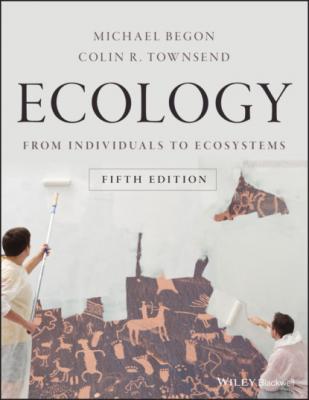Ecology. Michael Begon
Читать онлайн.| Название | Ecology |
|---|---|
| Автор произведения | Michael Begon |
| Жанр | Биология |
| Серия | |
| Издательство | Биология |
| Год выпуска | 0 |
| isbn | 9781119279310 |
Figure 5.25 Exponential (solid line) and sigmoidal (dashed line) increase in density (N) with time for models of continuous breeding. The equation giving sigmoidal increase is the logistic equation.
the logistic equation
Intraspecific competition can be added to Equation 5.20 by a method exactly equivalent to the one used in Figure 5.18b, giving rise to:
(5.21)
This is known as the ‘logistic’ equation, and a population increasing in size under its influence is also shown in Figure 5.25.
The logistic equation is the continuous equivalent of Equation 5.12, and it therefore has all the essential characteristics of Equation 5.12, and all of its shortcomings. It describes a sigmoidal growth curve approaching a stable carrying capacity, but it is only one of many reasonable equations that do this. Its major advantage is its simplicity. Moreover, while it was possible to incorporate a range of competitive intensities into Equation 5.12, this is by no means easy with the logistic equation. The logistic is therefore doomed to be a model of perfectly compensating density dependence. Nevertheless, in spite of these limitations, the equation will be an integral component of models in Chapters 8 and 10, and it has played a central role in the development of ecology.
5.8 Individual differences: asymmetric competition
5.8.1 Size inequalities
Until now, we have focused on what happens to the whole population or the average individual within it. Different individuals, however, may respond to intraspecific competition in very different ways. For example, when larval salamanders (Ambystoma tigrinum nebulosum) were competed amongst one another in groups, the sizes of the largest surviving larvae were no different from those reared alone (P = 0.42) but the smallest larvae were much smaller (P < 0.0001) (Ziemba & Collins, 1999). Similarly, the overwinter survival of red deer calves, Cervus elaphus, in the resource‐limited population on the island of Rhum, Scotland, declined sharply as the population became more crowded, but those that were smallest at birth were by far the most likely to die (Clutton‐Brock et al., 1987). The effects of competition are far from being the same for every individual. Weak competitors may make only a small contribution to the next generation, or no contribution at all. Strong competitors may have their contribution only negligibly affected.
What effect does this have at the population level? Figure 5.26 shows the results of a classic experiment in which flax (Linum usitatissimum) was sown at three densities, and harvested at three stages of development, recording the weight of each plant individually. This made it possible to monitor the effects of increasing amounts of competition not only as a result of variations in initial density, but also as a result of plant growth (between the first and the last harvests). When intraspecific competition was at its least intense (at the lowest sowing density after only two weeks’ growth) the individual plant weights were distributed symmetrically about the mean. When competition was at its most intense, however, the distribution was strongly skewed to the left: there were many very small individuals and a few large ones. As the intensity of competition gradually increased, the degree of skewness increased as well. Something very similar seems to be happening with the data in Figure 5.27 for cod (Gadus morhua) living off the coast of Norway. At higher densities (and presumably greater intensities of competition) size decreased but the skewness in the distribution of sizes increased.
Figure 5.26 Intraspecific competition increases the skewing in the distribution of plant weights. Frequency distributions of individual plant weights in populations of flax (Linum usitatissimum), sown at three densities and harvested at three ages. The red bar is the mean weight.
Source: After Obeid et al. (1967).
Figure 5.27 Intraspecific competition increases the skewing in the distribution of cod lengths but decreases mean length. (a) Values of density and of skewness in the frequency distribution of lengths, both expressed as standard deviations from mean values, for the years 1957–94 for cod (Gadus morhua) from the Skagerrak, off the coast of Norway. (b) Similar patterns for skewness and mean length. Despite marked fluctuations from year to year, much of it the result of variations in weather, when density rose, that is, when competition was most intense, skewness tended also to rise (r = 0.58, P < 0.01) but mean length tended to decline (r = −0.45, P < 0.05).
Source: After Lekve et al. (2002).
the inadequacy of the average
Skewness aside, we can say more generally that increased competition tends to increase the degree of size inequality within a population, at least initially (Weiner, 1990). Characterising a population by an arbitrary ‘average’ individual can therefore be very misleading under such circumstances, and can divert attention from the fact that intraspecific competition is a force affecting individuals, even though its effects may often be detected in whole populations.
5.8.2 The generation and dilution of size inequalities
The processes by which these size inequalities may be generated, and also ultimately diminished, are illustrated by a study of competition in two separate species of large brown seaweed, Laminaria digitata and Fucus serratus, off the Isle of Man, UK, reared at a range of densities, from 650 to 5156 plants per m2 (Figure 5.28). We can see, firstly, that for all populations there was, for a large part of the experiment, a marked tendency for size inequality to increase (Figure
